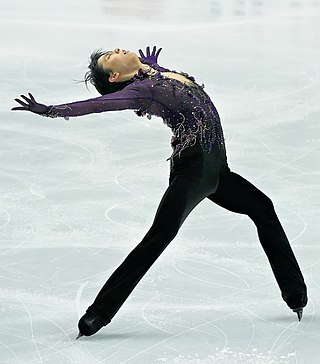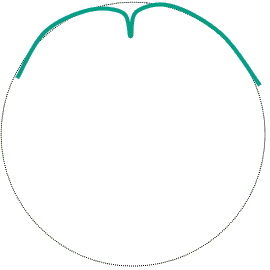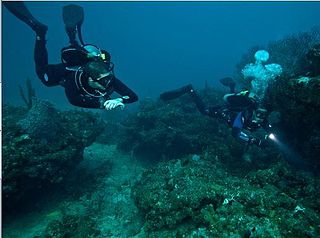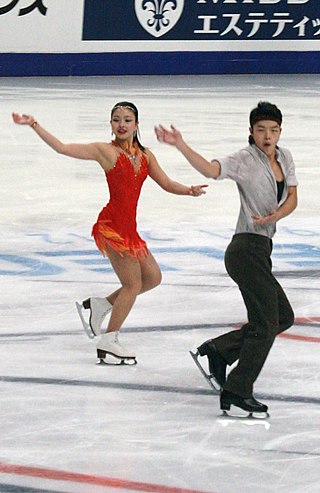An alphabetic list of modern country dance terminology:

Figure skating is a sport in which individuals, pairs, or groups perform on figure skates on ice. It was the first winter sport to be included in the Olympic Games, with its introduction occurring at the 1908 Olympics in London. The Olympic disciplines are men's singles, women's singles, pair skating, and ice dance; the four individual disciplines are also combined into a team event, which was first included in the Winter Olympics in 2014. The non-Olympic disciplines include synchronized skating, Theater on Ice, and four skating. From intermediate through senior-level competition, skaters generally perform two programs, which, depending on the discipline, may include spins, jumps, moves in the field, lifts, throw jumps, death spirals, and other elements or moves.

A kick is a physical strike using the leg, in unison usually with an area of the knee or lower using the foot, heel, tibia (shin), ball of the foot, blade of the foot, toes or knee. This type of attack is used frequently by hooved animals as well as humans in the context of stand-up fighting. Kicks play a significant role in many forms of martial arts, such as capoeira, kalaripayattu, karate, kickboxing, kung fu, wing chun, MMA, Muay Thai, pankration, pradal serey, savate, sikaran, silat, taekwondo, vovinam, and Yaw-Yan. Kicks are a universal act of aggression among humans.

Double push is an inline speed skating technique. Its major advantage over the previously practised "classic" technique is that it allows the skater to do useful work during the part of the stride that was "wasted", and therefore to go faster. Opinions differ on its usefulness for non-elite skaters as it requires much practice before a skater is faster using doublepush than without.

Compulsory figures or school figures were formerly a segment of figure skating, and gave the sport its name. They are the "circular patterns which skaters trace on the ice to demonstrate skill in placing clean turns evenly on round circles". For approximately the first 50 years of figure skating as a sport, until 1947, compulsory figures made up 60 percent of the total score at most competitions around the world. These figures continued to dominate the sport, although they steadily declined in importance, until the International Skating Union (ISU) voted to discontinue them as a part of competitions in 1990. Learning and training in compulsory figures instilled discipline and control; some in the figure skating community considered them necessary to teach skaters basic skills. Skaters would train for hours to learn and execute them well, and competing and judging figures would often take up to eight hours during competitions.
The toe loop jump is the simplest jump in the sport of figure skating. It was invented in the 1920s by American professional figure skater Bruce Mapes. The toe loop is accomplished with a forward approach on the inside edge of the blade; the skater then switches to a backward-facing position before their takeoff, which is accomplished from the skater's right back outside edge and left toepick. The jump is exited from the back outside edge of the same foot. It is often added to more difficult jumps during combinations and is the most common second jump performed in combinations. It is also the most commonly attempted jump.
In human biology, footedness is the natural preference of one's left or right foot for various purposes. It is the foot equivalent of handedness. While purposes vary, such as applying the greatest force in a certain foot to complete the action of kick as opposed to stomping, footedness is most commonly associated with the preference of a particular foot in the leading position while engaging in foot- or kicking-related sports, such as association football and kickboxing. A person may thus be left-footed, right-footed or ambipedal.

A three-turn is a figure skating element which involves both a change in direction and a change in edge. For example, when a skater executes a forward outside three-turn, the skater begins on a forward outside edge and finishes on a backwards inside edge. There are eight three-turns in all; one for each possible combination of direction, skating foot, and edge.
A mohawk is a figure skating turn that involves a change of skating foot but not a change of edge. It is a turn from one foot to the other, from forward to backwards in which the entry and exit curves are continuous and of equal depth.
Kimarite is the technique used in sumo by a rikishi (wrestler) to win a match. It is officially decided or announced by the gyōji (referee) at the end of the match, though judges can modify this decision. The records of kimarite are then kept for statistical purposes.

Finning techniques are the skills and methods used by swimmers and underwater divers to propel themselves through the water and to maneuver when wearing swimfins. There are several styles used for propulsion, some of which are more suited to particular swimfin configurations. There are also techniques for positional maneuvering, such as rotation on the spot, which may not involve significant locational change. Use of the most appropriate finning style for the circumstances can increase propulsive efficiency, reduce fatigue, improve precision of maneuvering and control of the diver's position in the water, and thereby increase the task effectiveness of the diver and reduce the impact on the environment. Propulsion through water requires much more work than through air due to higher density and viscosity. Diving equipment which is bulky usually increases drag, and reduction of drag can significantly reduce the effort of finning. This can be done to some extent by streamlining diving equipment, and by swimming along the axis of least drag, which requires correct diver trim. Efficient production of thrust also reduces the effort required, but there are also situations where efficiency must be traded off against practical necessity related to the environment or task in hand, such as the ability to maneuver effectively and resistance to damage of the equipment.

The chassé is a dance step used in many dances in many variations. All variations are triple-step patterns of gliding character in a "step-together-step" pattern. The word came from ballet terminology.
The following is a glossary of figure skating terms, sorted alphabetically.

The death spiral is a figure skating term used to describe a spin involving two partners in the discipline of pair skating, in which one partner lowers the other partner while the partner getting close to the ice arches backward on one foot. It was created by German professional skater Charlotte Oelschlägel and her husband Curt Newmann in the 1920s. Suzanne Morrow and Wallace Diestelmeyer from Canada were the first pair team to perform the death spiral one-handed, at the 1948 Olympic Games. In the 1960s, Soviet pair team Liudmila Belousova and Oleg Protopopov created three death spirals: "the backward-inside, forward-inside and forward-outside death spirals, which they originally named the Cosmic Spiral, Life Spiral and Love Spiral, respectively". The International Skating Union (ISU), the governing body that oversees figure skating, allows for variations of arm holds and pivot positions. Senior pair skating teams must perform different types of death spirals in their short programs and free skating programs.
British Ice Skating is the national governing body of ice skating within the United Kingdom. Formed in 1879, it is responsible for overseeing all disciplines of ice skating: figure skating ; synchronised skating; and speed skating.
A step sequence is a required element in all four disciplines of figure skating, men's single skating, women's single skating, pair skating, and ice dance. Step sequences have been defined as "steps and turns in a pattern on the ice". Skaters earn the most points in step sequences by performing steps and movements with "flair and personality", by turning in both directions, by using one foot and then the other, and by including up and down movements.

Ice dance, a discipline of figure skating, has required elements that make up a well-balanced rhythm dance program and free dance program, which must be performed during competitions. They include: the dance lift, the dance spin, the step sequence, turn sequences, and choreographic elements. The elements must be performed in specific ways, as described by published communications by the International Skating Union (ISU), unless otherwise specified. The ISU has also provided a list of illegal movements.












